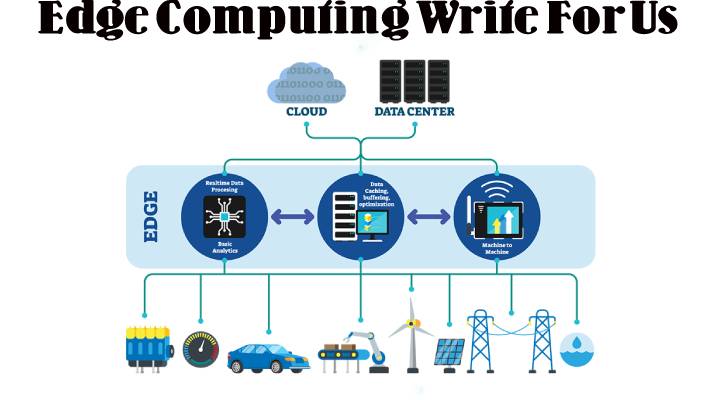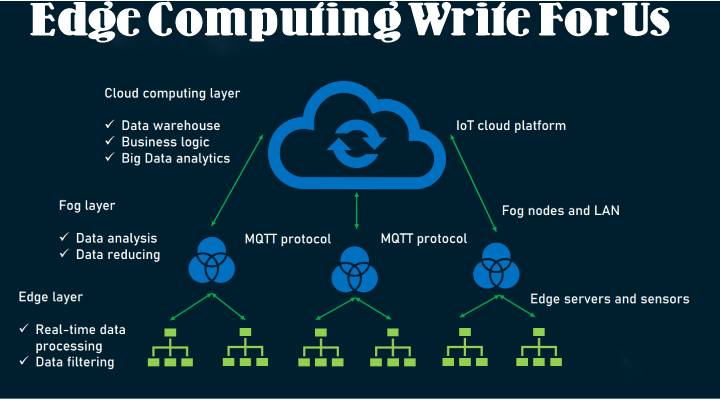Edge Computing Write For Us
Edge computing refers to the computing infrastructure close to data sources, for example, industrial machines or controllers bringing computational capabilities to sensors and data collection devices.
To Write for Us, you can email us at contact@tipsfromcomputertechs.com
Business applications are located close to data sources, such as on-premises edge servers and IoT devices, to achieve this. By doing this, organizations can gain insights from data much faster and speed up response times.
Edge Computing Components
- Gateways
- Edge nodes
- Cloud services:
Why is Edge Computing so Important?
Over the past two decades, the explosive advancement of technology has made the world more data-centric. Thanks to the development and availability of IoT devices, businesses now have access to never-before-seen levels of data.
While this is great, analyzing and getting meaningful insights from large amounts of data is challenging. And with 5G networks just around the corner, the speed at which data generates only for increase.
It is where edge computing comes into play. Edge computing allows companies to store and analyze data closer to the source. It eliminates latency issues with cloud computing, making it easier for companies to extract real-time insights from their data.
It also allows businesses to access more powerful computing resources at the edge of their network. Thus, they can quickly process large volumes of data and address specific use cases that require fast response times, such as autonomous vehicles.
How does Edge Computing Work?
Traditionally, data generated at endpoints is transmitted over a wireless access network (WAN) to a local area network (LAN) for storage and analysis. The extracted information is then transmitted to the client endpoint.
This method is effective and reliable, but only up to a point. The process loses efficiency as the number of internet-connected devices and the data they generate increase.
Edge computing is a distributed computing architecture that brings storage and computing closer to the data source, an endpoint device, or a sensor. It allows data to be processed and analyzed closer to the head, eliminating the need for a central processing unit.
Edge computing means businesses can access the information they need in real time without waiting for data to transfer from the cloud. It enables the company to make informed decisions and act faster.
Key Features of Edge Computing
Edge computing has some key features that set it apart from other computing models:
- Ultra-high network performance
- Flexibility of implementation
- Differentiated experiences
- Integrated virtual scanning and real-time analysis
- Automation and organization
- Decentralized processing
- Security.
- Scalability
Edge Computing Example
Consider a listed building with dozens of high-definition IoT video cameras. These “dummy” cameras output a raw video signal and continuously stream that signal to a cloud server.
On the cloud server, the video output from all cameras is passed through a motion detection application to ensure that only clips with activity are saved to the server’s database.
That means there is a constant and significant strain on the building’s Internet infrastructure, as the high volume of video streams being transferred consumes considerable bandwidth. Also, the cloud server has a hefty load that simultaneously processes the video streams from all the cameras.
Now imagine the motion sensor computation moves the network perimeter. What if each camera used its internal computer to run the motion detection application and then sent images to the cloud server as needed?
It significantly reduces bandwidth usage, as much camera footage will not have to travel to the cloud server.
Also, the cloud server will now only be responsible for storing the important images, which means the server could communicate with many cameras without overloading. It is how edge computing works.
What are Other Potential use Cases for Edge Computing?
It can be incorporated into various applications, products, and services. Some possible use cases could be:
- Security System Monitoring: As described above.
- IoT Devices: Smart devices that connect to the Internet can take advantage of executing code on the device itself, rather than in the cloud, for more efficient user interactions.
- Autonomous Cars: Autonomous vehicles must react in real time without waiting for orders from a server.
- More efficient caching: By running code on a CDN perimeter, an application can customize how content is cached to serve content to users more efficiently.
- Medical monitoring devices: Medical devices must respond in real time without waiting for news from a cloud server.
- Video conferencing: Live interactive video requires significant bandwidth, so moving back-end processes closer to the video source can decrease delay and latency.
How to Submit Your Articles and Write For Us
To submit guest posts, please study through the guidelines mentioned below. You can contact us finished the website contact form or at contact@tipsfromcomputertechs.com
Why Write for Tips From Computer Techs – Edge Computing For Us
- If you write to us, your business is targeted, and the consumer can read your article; you can have huge exposure.
- This will help in building relationships with your beleaguered audience.
- If you write for us, the obvious of your brand and contain worldly.
- Our presence is also on social media, and we share your article on social channels.
- You container link back to your website in the article, which stocks SEO value with your website.
Search Related Terms to Edge Computing Write For Us
- Edge computing
- Edge devices
- Edge servers
- Edge analytics
- Edge AI
- Edge computing architecture
- Edge computing vs cloud computing
- Edge computing benefits
- Edge computing applications
- Edge computing use cases
- Edge computing challenges
- Edge computing security
- Edge computing latency
- Edge computing infrastructure
- Edge computing technologies
- Edge computing platforms
- Edge computing frameworks
- Edge computing and IoT
- Edge computing and 5G
- Edge computing and data privacy
Search Terms for Write For Us
Edge Computing Write for Us
Write for Us Edge Computing
Edge Computing Guest Post
Guest Post Edge Computing
Edge Computing Contribute
Contribute Edge Computing
Edge Computing Submit Post
Submit Post Edge Computing
Edge Computing submit an article
Submit an article Edge Computing
Edge Computing become a guest blogger
A guest blogger Edge Computing
Edge Computing writers wanted
Wanted writers Edge Computing
Edge Computing suggest a post
Suggest a post Edge Computing
Edge Computing guest author
Guest author Edge Computing
Article Guidelines on Tips From Computer Techs – Edge Computing Write For Us
- The author cannot be republished their guest post content on any other website.
- Your article or post should be unique, not copied or published anywhere on another website.
- The author cannot be republished their guest post content on any other website.
- You cannot add any affiliates code, advertisements, or referral links are not allowed to add into articles.
- High-quality articles will be published, and poor-quality papers will be rejected.
- An article must be more than 350 words.
- You can send your article to contact@tipsfromcomputertechs.com



